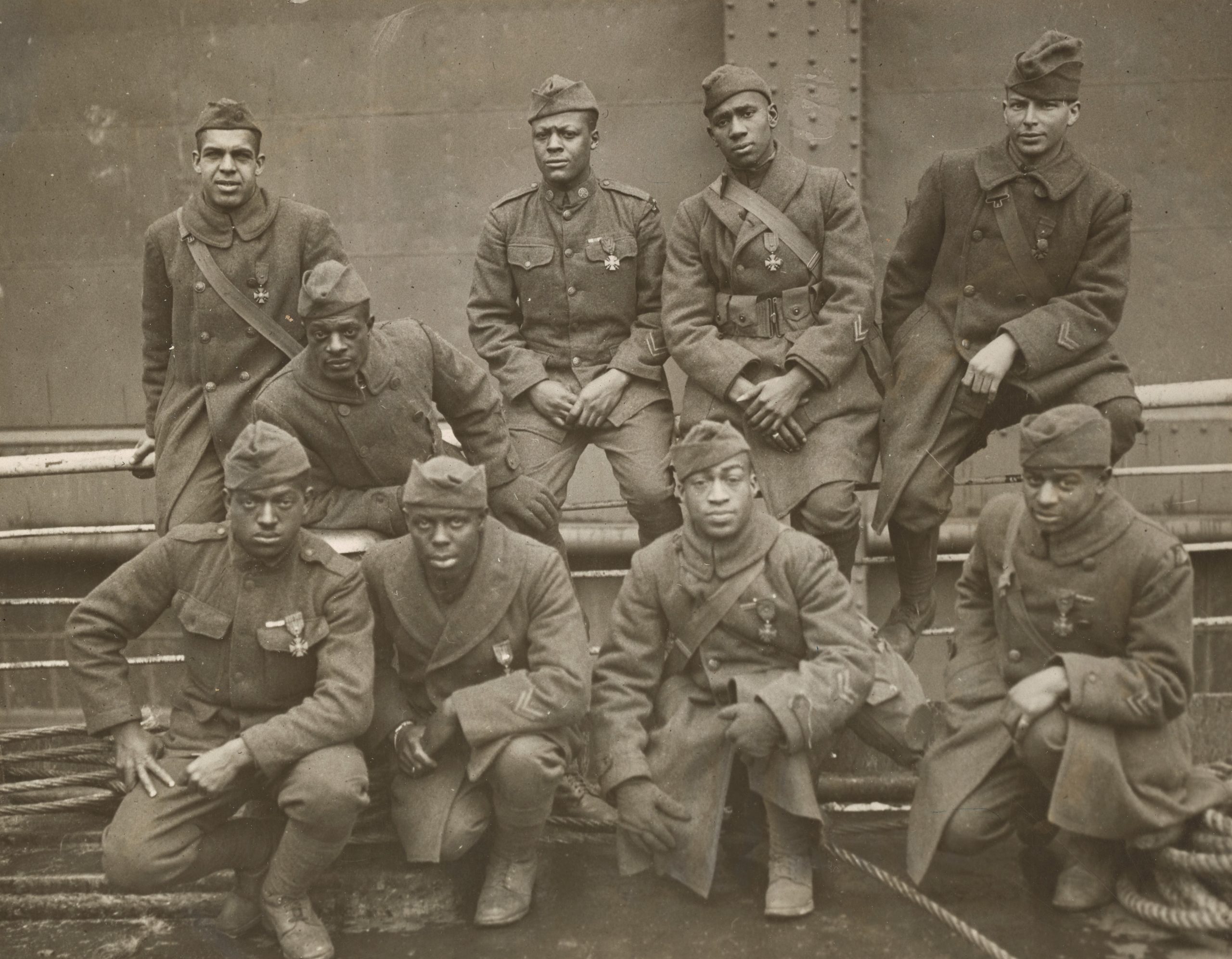
Soldiers from the 369th Infantry Regiment returning from France. National Archives
How to register:
We offer two field trip scheduling options:
- Select a field trip from the Museum’s public event schedule
- Request to schedule a field-trip at a time that meets your group’s schedule
Audience: All audiences. Content appropriate for Grades 6-12.
Goal: Recognize the commitment, challenges, and sacrifices of the Harlem Hellfighters.
Program Description:
From the Revolutionary War and through the present day, African Americans have proudly served the U.S. Army, many serving in segregated units and not always given the respect and honor due to them.
On Dec. 27, 1917, the 369th Infantry Regiment docked in Brest, France. The all-Black regiment, comprised of men from Harlem, New York and surrounding cities, were assigned to the Service of Supplies — unloading ships and building roads and railroads. Three months later, the regiment was transferred to the French Army where they were given a position on the frontlines and earned a new nickname: “Hellfighters.” In the 191 days the men spent on the front lines no ground was lost and no man was captured. Their actions earned them accolades in France and they were celebrated on their return to the United States.
Explore the commitment, challenges, and bravery of the Harlem Hellfighters. Learn how their actions, along with the thousands of other Black World War I veterans, contributed to the Allied victory. Examine the legacy of their service and its impact on the civil rights movement.
Objective: At the end of this lesson students, will be able to
- Describe the U.S. Army’s role in World War I.
- Understand how African Americans have used military service as a strategy to advance civil rights.
- Describe the impact of the African American military service on the home front before, during, and following World War I.
Guiding Questions:
How did African American military service in World War I contribute to the civil rights movement?
Curriculum Connections
Common Core Standards
- CCSS.ELA-LITERACY.RH.6-8.2
Determine the central ideas or information of a primary or secondary source; provide an accurate summary of the source distinct from prior knowledge or opinions.
History and Social Science Standards of Learning for Virginia Public Schools
-
United States History 1865 to Present
-
USII.4 The student will apply history and social science skills to explain the changing role of the United States from the late 19th century through World War I by
- C) analyzing the major causes and consequences of World War I and examining the roles of key leaders and groups.
-
USII.5 The student will apply history and social science skills to understand the social, political, economic, and technological changes of the early 20th century by
- H) describing racial segregation, housing discrimination via redlining, the rise of “Jim Crow” laws, Black Codes, and threats of violence, including, but not limited to intimidation, lynchings, armed conflicts, suppressed voting rights, and limits on political participation faced by African Americans and other people during post-Reconstruction.
- I) analyzing events and impacts of African American leaders in response to “Jim Crow,” including, but not limited to the formation of the NAACP, strikes, protests, the role of HBCUs, and the work of leaders like Booker T. Washington, W.E.B. DuBois, Mary White Ovington, Ida B. Wells-Barnett.
-
USII.4 The student will apply history and social science skills to explain the changing role of the United States from the late 19th century through World War I by
-
Virginia and United States History
-
VUS.11 The student will apply history and social science skills to analyze the emerging role of the United States in world affairs during the end of the 19th and early 20th centuries by
- C) evaluating the events, leaders, and changes that brought America out of a period of isolationism to enter WWI.
- D) evaluating the United States’ involvement in World War I, including, but not limited to Woodrow Wilson’s Fourteen Points and the establishment of the League of Nations.
-
VUS.12 The student will apply history and social science skills to understand key international and domestic events, interests, and philosophies of the 1920s and 1930s by
- A) analyzing the attacks on civil liberties, including, but not limited to the re-emergence of the Ku Klux Klan, the Chicago riot of 1919, the Tulsa Race Massacre and the decimation of Black Wall Street, and the institution of redlining and resulting racial wealth gaps.
-
VUS.11 The student will apply history and social science skills to analyze the emerging role of the United States in world affairs during the end of the 19th and early 20th centuries by
Your message has been submitted.
